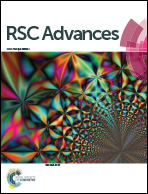Facile in situ growth of Fe3O4 nanoparticles on hydroxyapatite nanorods for pH dependent adsorption and controlled release of proteins†
Abstract
A general one-pot hydrothermal process was used to prepare different sizes of Fe3O4 nanoparticles dispersed on hydroxyapatite nanorods with CTAB as a surfactant. We also explore the role of hydrothermal reaction temperature and the surfactant on the crystallinity and formation of the rod like morphology of HAp. The obtained nanoparticles are systematically studied by X-ray powder diffraction (XRD), Fourier-transform infrared spectroscopy, Raman spectroscopy, field emission scanning electron microscopy (FESEM) with EDS for elemental mapping, transmission electron microscopy (TEM), Brunauer–Emmett–Teller (BET) nitrogen sorptometry and vibrating sample magnetometry (VSM). The as-synthesized Fe3O4/HAp nanocomposites are further explored to study the pH dependent protein adsorption and controlled release using hemoglobin (Hb) as a model protein. A maximum protein adsorption (Qo) of 166.67 mg g−1 is observed for the Fe3O4/HAp nanocomposite and it increases to 200.07 mg g−1 upon increasing the concentration of Fe3O4 nanoparticles. The pH controlled sustained release process is observed for Hb at various pH values of 4.0, 7.4 and 9.0 in phosphate buffer saline (PBS) solution at room temperature. The maximum protein release was obtained for the lower pH values. The dosage dependent in vitro cytotoxicity assays are also performed to confirm biocompatibility of the prepared samples.


 Please wait while we load your content...
Please wait while we load your content...